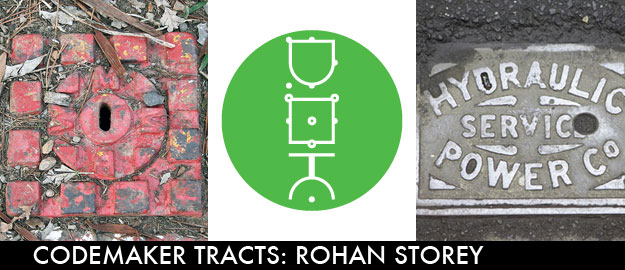Rohan Storey ::: National Trust of Australia
Have you ever looked down at the pavement and had a good look at any of those inspection covers? I saw one the other day, a small square metal plate embossed with the letters “GFC”. Global Financial Crisis immediately sprang to mind, but no, of course that isn’t what it stands for – I knew what it was, but anyone without a knowledge of the history of Melbourne’s various utilities would not.
The inspection covers across Melbourne, especially in the CBD, are markers of a range of utilities. Some are now redundant, and those that remain from before the privatisation mania of the 1990s feature the initials or logos of boards, commissions or companies now fading from memory. The covers identify underground networks that serve the buildings, but generally run along city streets, often the footpath, and down many of the laneways, paralleling the subdivision patterns of Melbourne’s CBD.
The first was gas for street lighting. The Melbourne Gas & Coke Co established a gasworks about where the new ANZ building is in the Docklands, where imported coal was turned into gas. It was piped throughout the city by 1856, by digging up the streets to lay the mains, providing gas for street lighting and whoever else wanted it.
The next year the streets were dug up again for a fresh water supply, arriving from the Yan Yean reservoir in late 1857. This was a government initiative, overseen by the Board of Commissioners of Sewerage and Water Supply, which in 1860 became that Department of Sewerage and Water Supply within the Board of Land and Works.
The next and most unusual was a system of pressurised water piped through the streets, used to power elevators. This was a private initiative of the Melbourne Hydraulic Power Co., and by the middle of 1890, the first year of operation, 250 lifts were connected. Many buildings already had lifts, some using their own engines and cables, others using mains pressure water to push up a rod under the lift, causing it to gently (and safely) rise to the desired floor. The pressurised water supply provided a superior and more reliable means of hydraulic lift power, seen as a safer alternative to cables. Melbourne was one of only a handful of cities worldwide to install such a system, and it is credited with allowing the sudden increase in height of city buildings from the average three or four storeys to ‘skyscrapers’ up to 12 floors high.
This system was also particularly useful for goods lifts, so it stayed in place long after electric lifts for passengers became the norm. Flinders Lane was and still is lined with multi-storey warehouses that invariably had a goods lift at the rear accessed from a lane down one side, and so the hydraulic system strongly paralleled the pattern of the little streets and their branching lanes. The system was taken over by the Melbourne City council in the 1920s and kept operating into the 1960s. The lanes were once dotted with the inspection covers of the Melbourne Hydraulic Power Dept, and a few still remain.
Telephones first arrived in the city in 1880, operated by Melbourne Telephone Company. But by 1887, this and other private telephone companies were in disarray, and so were ‘nationalised’ and placed in the care of the Post Office. At that time, and for the next century or so, the postal service was named after its manager, the Postmaster General. Telephone and telegraph services were at first carried on overhead wires, but by 1900 the number of wires required in the CBD was such that the poles had twenty or more cross arms. Soon the streets were dug up yet again and the telephones went underground, so in the city, if you see a cover or post with PMG, you are looking at a telephone access point. In the 1970s, this became Telecom, later Telstra, and covers with both names and logos can be found. New covers just say ‘telephone’.
Sewerage came relatively late to Melbourne, by all accounts earning its nick-name ‘Smelbourne’. In the 1890s the Melbourne and Metropolitan Board of Works was established to build and operate an extensive system, ending the practice of ‘nightsoil’ carts trundling through the streets after dark. The Board also took over responsibility for water supply, and for the next century the M&MBW was shorthand for all water and sewerage. Covers large and small, concrete and metal can be found, usually embossed with MMBW.
Electricity was first produced by private companies in Melbourne in the 1880s, and in the 1890s, the City of Melbourne decided to provide a municipal supply for street lighting. The first section of the now mostly demolished Lonsdale Street Power Station was built for this purpose in 1894, and operated by the Melbourne City Council Electricity Supply Department, or MCCESD. They built substations still dotted around the CBD, and put the wires underground early in the 20th century. Some covers with these initials may still survive in the city streets. While the MCCESD was providing power around the CBD, they were in competition with the government run State Electricity Commission of Victoria, or SEC. Access covers identifying their service lines can also be found. New covers now simply say ‘electricity’.
And the GFC ? Well the Melbourne Gas & Coke Company later became the Metropolitan Gas Company, until it too was ‘nationalised’ in 1951, with the decision to provide gas made from brown coal in the La Trobe valley. Perhaps in recognition that it was a business rather than a service, rather then create a board, the new body was called the Gas & Fuel Corporation. New covers now just say ‘gas’.

Pingback: Forgotten manhole covers of Melbourne | Waking up in Geelong